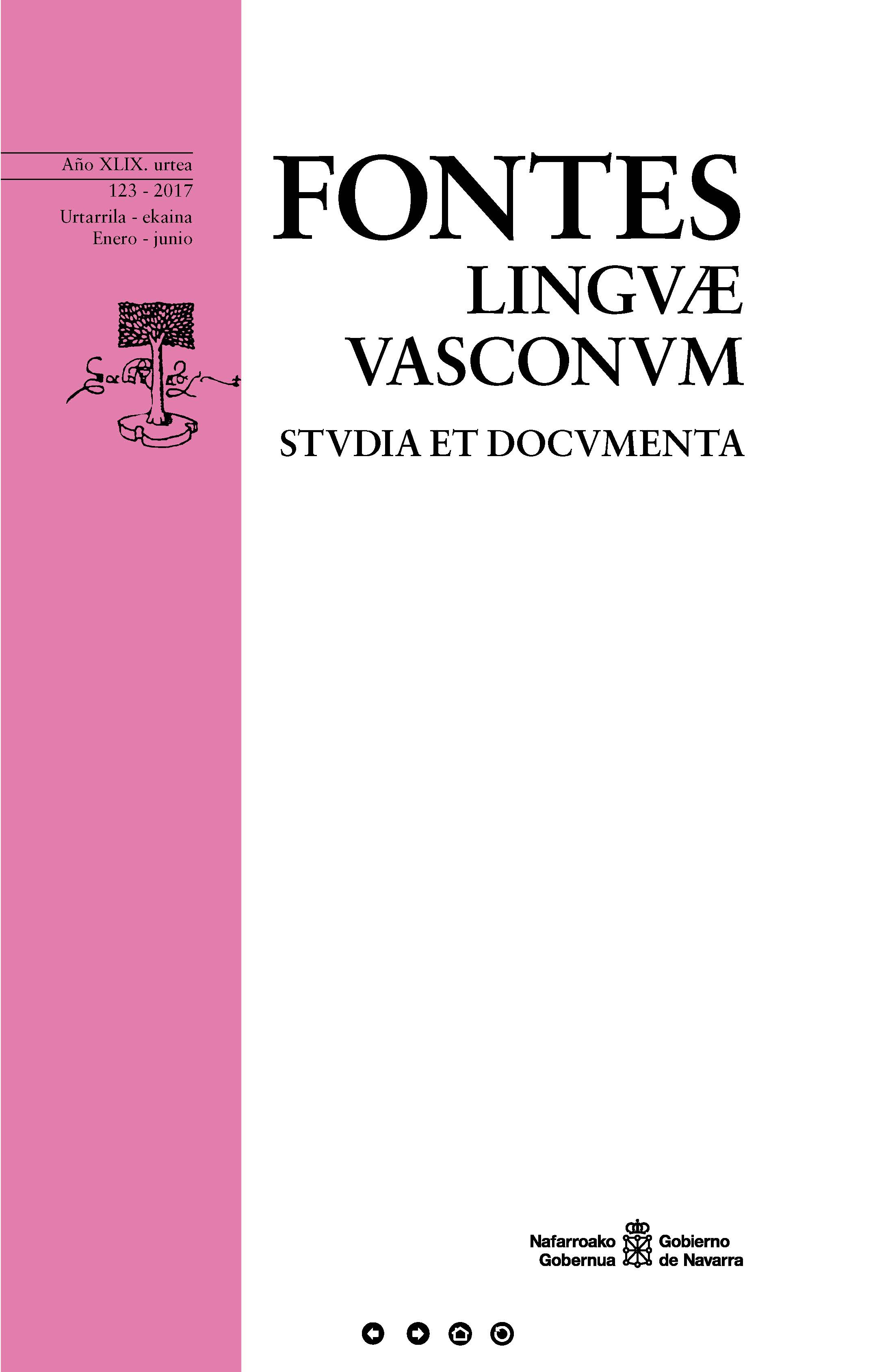Zatoz! Agindua da! Euskal aginteraren azterketa formal baterako lehen urratsak [¡Ven! ¡Es una orden! Primeros pasos hacia un análisis formal de las oraciones imperativas del euskera]
Resumen
El objetivo de este trabajo es dar los primeros pasos hacia un análisis formal de las oraciones imperativas del euskera. Una de las características distintivas de estas oraciones tiene que ver con el sujeto: por un lado, el sujeto elidido siempre se interpreta como sujeto de 2.ª persona, y por otro, el sujeto se puede silenciar incluso en lenguas sin elisión de sujeto. Estas propiedades pueden explicarse mediante la presencia de una proyección funcional con rasgos de 2.ª persona (Zanuttini, 2008). Asimismo, este análisis permite explicar las oraciones imperativas con sujetos diferentes al de 2.ª persona, tal y como mostraré extendiendo la propuesta de Zanuttini al euskera. Por último, analizaré algunos de los fenómenos que emergen de las oraciones imperativas negativas.
Estadísticas
Referencias
Aikhenvald, A. Y. (2010). Imperatives and Commands. Oxford: Oxford University Press. https://doi.org/10.1093/oso/9780198803225.003.0001
Alcázar, A. & Saltarelli, M. (2014). The Syntax of Imperatives. Cambridge: Cambridge University Press. https://doi.org/10.1017/CBO9780511794391
Artiagoitia, X. (2000). Hatsarre eta parametroak lantzen. Gasteiz: Arabako Foru Aldundia.
Artiagoitia, X. (2012). The DP Hypothesis in the grammar of Basque. In U. Etxeberria, R. Etxepare & M. Uribe-Etxeberria (arg.), Noun Phrases and Nominalization in Basque: Syntax and semantics (21-78 orr.). Dordrecht: John Benjamins. https://doi.org/10.1075/la.187.04art
Azkue, R. M. (1925). Morfología Vasca. Bilbo: La Gran Enciclopedia Vasca.
Bennis, H. (2006). Agreement, pro and imperatives. P. Ackema, P. Brandt, M. Schoorlemmer & F. Weerman (arg.), Arguments and agreement (101-123 orr.). Oxford: Oxford University Press.
Berro, A. (2015). Breaking verbs. From event structure to syntactic categories in Basque. Doktore tesia. UPV/EHU & Université Bordeaux Montaigne (UBM). Hemendik hartua: http://basdisyn.net/pdf/Berro%20tesia1009.pdf
Birjulin, L.A. & Xrakovskij, V. S. (2001). Imperative sentences: theoretical problems. V.S. Xrakovskij (arg.), Typology of Imperative Constructions (3-54 orr.). Munich: LINCOM Europa.
De Rijk, R. P. G. (2008). Standard Basque. A Progressive Grammar. Cambridge MA: The MIT Press.
Duguine, M. (2010). Argumentu isilak eta hizkuntz aldakortasuna. Bilbo: Udako Euskal Unibertsitatea.
Etxeberria, U. (2010). -a, -ak eta -(r)ik euskal hizkeretan zehar. B. Fernandez, P. Albizu eta R. Etxepare (arg.), Euskara eta euskarak. Aldakortasun sintaktikoa aztergai (65-83 orr.). Bilbo: UPV/EHU.
Etxepare, R. (2003). Negation. Hualde, J. I. & Ortiz de Urbina, J. (arg.), A grammar of Basque (516-563 orr.). Berlin: Mouton de Gruyter.
Euskaltzaindia. (1987). Euskal Gramatika. Lehen Urratsak-II (EGLU-II). Bilbo: Euskaltzaindia. Euskara Institutua, UPV/EHU. Agintera perpausa. Sareko Euskal Gramatika (SEG). www.ehu.eus/seg helbidetik berreskuratua.
Hualde, J. I. & Ortiz de Urbina, J. (arg.). (2003). A grammar of Basque. Berlin: Mouton de Gruyter.
Hualde, J. I., Oyharçabal, B. & Ortiz de Urbina, J. (2003). Finite forms. In Egileak (arg.), A grammar of Basque (205-245 orr.). Berlin: Mouton de Gruyter.
Kayne, R. (1993). Towards a Modular Theory of Auxiliary Selection. Studia Linguistica 47-1, 3-31. https://doi.org/10.1111/j.1467-9582.1993.tb00837.x
Lakarra, J. A. & Mounole, C. (argitaratzeko). Euskara Arkaikoa. J. Gorrochategui, I. Igartua & J. A. Lakarra (arg.), Euskararen Historia. Gasteiz: Eusko Jaurlaritza.
Lewis, M. P., Simons, G. F. & Fennig, C. D. (arg.). (2016). Ethnologue: Languages of the World, Nineteenth edition. Texas: SIL International. Hemendik hartua: http://www.ethnologue.com
Mauck, S., Pak, M., Portner, P. & Zanuttini, R. (2005). Imperative subjects: A Crosslinguistic Perspective. C. Brandstetter & D. Rus (arg.), Georgetown University Working Papers in Theoretical Linguistics (135-152 orr.). Georgetown University.
Mitxelena, K. (1960). Gipuzcoano y vasco. J. A. Lakarra & I. R. Arzalluz (arg.) (2011) Luis Michelena. Obras Completas. VII. Fonética y Fonología, Morfosintaxis y Dialectología (697-700 orr.). Donostia & Gasteiz: UPV/EHU.
Oyharçabal, B. (2000). Note à propos des formes jussives préfixées en b- du basque. Lapurdum, 5, 225-235. https://doi.org/10.4000/lapurdum.1316
Oyharçabal, B. (2003). Tense, aspect and mood. Hualde, J. I. & Ortiz de Urbina, J. (arg.), A grammar of Basque (249-283 orr.). Berlin: Mouton de Gruyter.
Ortiz de Urbina, J. (1989). Parameters in the Grammar of Basque. Dordrecht: Foris.
Portner, P. (2005). The Semantics of Imperatives within a Theory of Clause Types. K. Watanabe & R. B. Young (arg.), Proceedings of Semantics and Linguistic Theory, 14, 235-252. New York: CLC Publications. https://doi.org/10.3765/salt.v14i0.2907
Postma, G. & Van der Wurff, W. (2007). How to say no and don’t: Negative imperatives in Romance and Germanic. W. Van der Wurff (arg.), Imperative clauses in generative grammar (205-249 orr.). Amsterdam & Philadelphia: John Benjamins Publishing Company. https://doi.org/10.1075/la.103.08pos
Potsdam, E. (1998). Syntactic Issues in the English Imperative. New York: Garland.
Scatton, E. (1993). Bulgarian. B. Comrie & G. Corbett (arg.), The Slavonic Languages (188-248 orr.). London: Routledge.
Visser, F. Th. (1966). An Historical Syntax of the English Language. II Syntactical Units with One Verb (Continued). Leiden: E. J. Brill.
Zanuttini, R. (1997). Negation and Clausal Structure: A Comparative Study of Romance Languages. New York: Oxford University Press.
Zanuttini, R. (2008). Encoding the addressee in the syntax: evidence from English imperative subjects. Natural Language & Linguistic Theory, 26, 185-218. https://doi.org/10.1007/s11049-007-9029-6
Derechos de autor 2017 Itziar Orbegozo Arrizabalaga

Esta obra está bajo licencia internacional Creative Commons Reconocimiento-NoComercial 4.0.







